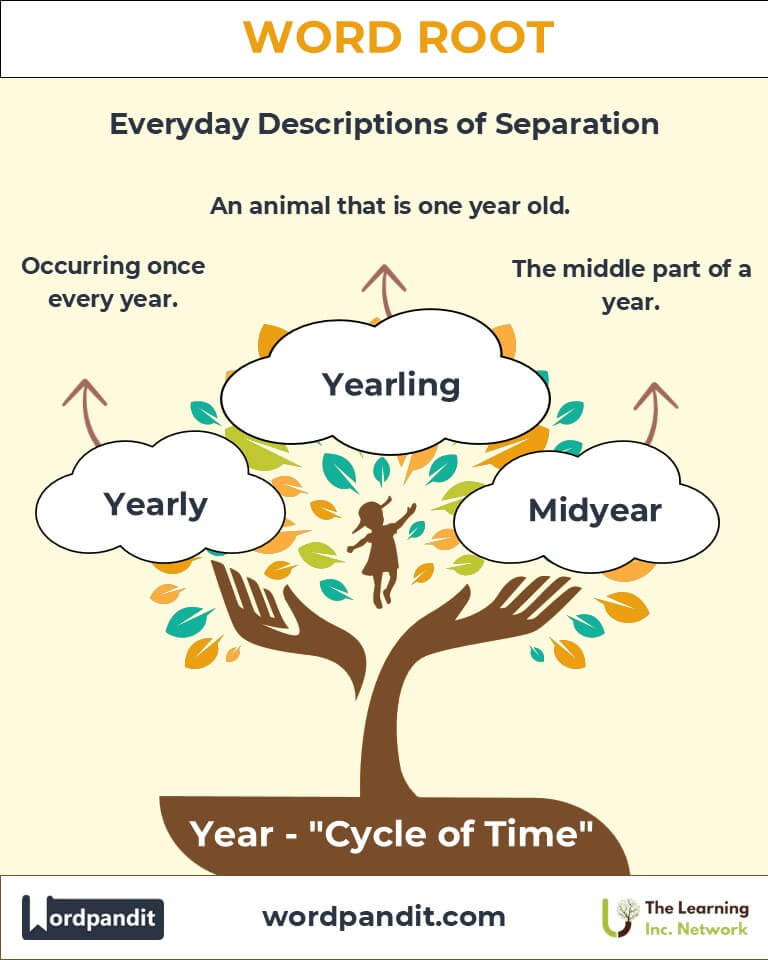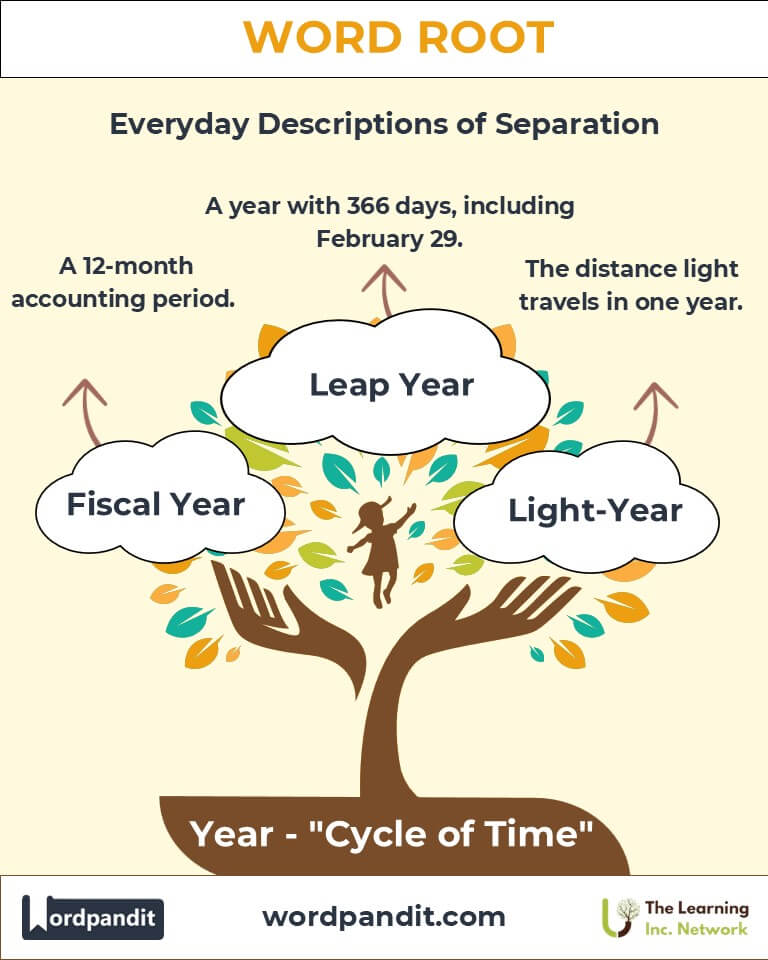Year: The Root of Annual Progression and Growth
Discover the significance of the word root "year," reflecting cycles of time and renewal. From terms like "yearly" and "yearling" to specialized uses in disciplines like agriculture and finance, this root traces humanity's connection to time, seasons, and growth.

Table of Contents
- Introduction: The Cyclical Essence of Year
- Etymology and Historical Journey
- Mnemonic: Unlocking the Power of Year
- Common Year-Related Terms
- Year Through Time
- Year in Specialized Fields
- Illustrative Story: Year in Action
- Cultural Significance of the Year Root
- The Year Family Tree
- FAQs About the Year Word Root
- Test Your Knowledge: Year Word Root Quiz
- Conclusion: The Living Legacy of Year
1. Introduction: The Cyclical Essence of Year
What does a year mean to you? A marker of time, a cycle of seasons, or an opportunity for renewal? The root "year", pronounced as "yeer," originates from Old English gear and Proto-Germanic jēr, symbolizing the passage of time. It embodies humanity's fascination with cycles, whether in nature, personal growth, or societal progression.

2. Etymology and Historical Journey
The root "year" stems from the Proto-Indo-European root yēr, meaning "season" or "spring." Early agricultural societies used this term to mark the passage of seasons, essential for planting and harvesting. Over centuries, "year" evolved to signify the completion of Earth's orbit around the sun, influencing calendars and timekeeping systems globally.
3. Mnemonic: Unlocking the Power of Year
To remember "year," imagine the cycle of four distinct seasons—spring, summer, autumn, and winter—returning annually.
Mnemonic Device: "Yearly seasons return, embracing Earth’s rhythmic turn."
4. Common Year-Related Terms
- Yearly (yeer-lee)
- Definition: Occurring once every year.
- Example: "The yearly festival attracts visitors from around the world."
- Yearling (yeer-ling)
- Definition: An animal that is one year old.
- Example: "The yearling colt galloped across the pasture."
- Midyear (mid-yeer)
- Definition: The middle part of a calendar or fiscal year.
- Example: "The company released its midyear financial report."
- New Year (noo-yeer)
- Definition: The start of a new calendar year.
- Example: "People celebrate the New Year with fireworks and resolutions."
- Leap Year (leep-yeer)
- Definition: A year with 366 days, including February 29.
- Example: "The next leap year will provide an extra day in February."
5. Year Through Time
- Old English "gear": Early references to the annual cycle, particularly for agriculture.
- Medieval Year Reckoning: Monks in Europe used years to record historical events, anchoring dates in religious and seasonal calendars.
- Modern Leap Year: Introduced in 1582 with the Gregorian Calendar to adjust for Earth's orbital inaccuracies.
6. Year in Specialized Fields
- Agriculture:
- Crop Year: A term marking the period for planting and harvesting specific crops.
- Example: "The wheat crop year starts in autumn."
- Finance:
- Fiscal Year: A 12-month period used for accounting purposes.
- Example: "The company’s fiscal year ends in March."
- Astronomy:
- Light-Year: The distance light travels in one year.
- Example: "A light-year measures the vast expanses of space."
7. Illustrative Story: Year in Action
Tara, a farmer, relied on the changing years to guide her planting schedule. Each year brought its challenges—droughts, floods, and bumper harvests. As she watched her yearlings grow into strong livestock, she marveled at how the passage of time shaped life on her farm. Every New Year, Tara made resolutions that aligned her goals with the rhythms of nature.
8. Cultural Significance of the Year Root
The root "year" is deeply woven into cultural traditions worldwide:
- New Year's Celebrations: From fireworks to resolutions, cultures mark the start of a new year with hope and festivity.
- Calendars: Lunar and solar calendars, used in different cultures, highlight the cyclical nature of years.
- Folklore: Many myths, such as the Greek story of Demeter and Persephone, revolve around annual cycles.

9. The Year Family Tree
- Ann- (Latin, "year")
- Annual: Occurring once every year.
- Anniversary: The yearly recurrence of a date.
- Chron- (Greek, "time")
- Chronology: The study of time sequences.
- Chronometer: A precise timekeeping device.

10. FAQs About " Year "
Q: What does the root "year" signify?
A: The root "year" comes from Old English "gēar," meaning a full cycle of seasons or 12 months. It is used in terms related to time, annual cycles, and age.
Q: What is an annual event?
A: An annual event is one that occurs once every year. The word "annual" derives from the Latin "annus," meaning year, emphasizing a yearly cycle.
Q: How does "biennial" differ from "biannual"?
A: "Biennial" refers to something that happens every two years, while "biannual" means occurring twice a year. Both terms are rooted in "annus," but they describe different time intervals.
Q: What is a perennial plant?
A: A perennial plant lives for more than two years, continuously growing and blooming during its life cycle. The word "perennial" combines "per-" (through) and "annus" (year), meaning lasting through years.
Q: Why does "anniversary" include the root "annus"?
A: "Anniversary" marks the yearly recurrence of a significant date or event. It combines "annus" (year) and "versary" (turning), highlighting the yearly cycle of remembrance.
11. Test Your Knowledge: " Year " Mastery Quiz
1. What does the root "year" mean?
2. What does an annual event mean?
3. What does biennial mean?
4. What is a perennial plant?
5. What does an anniversary celebrate?
12. Conclusion: The Living Legacy of Year
The root "year" serves as a testament to humanity's deep connection with time and cycles. Whether tracking agricultural seasons, celebrating cultural milestones, or measuring cosmic distances, the concept of the year remains essential to u











